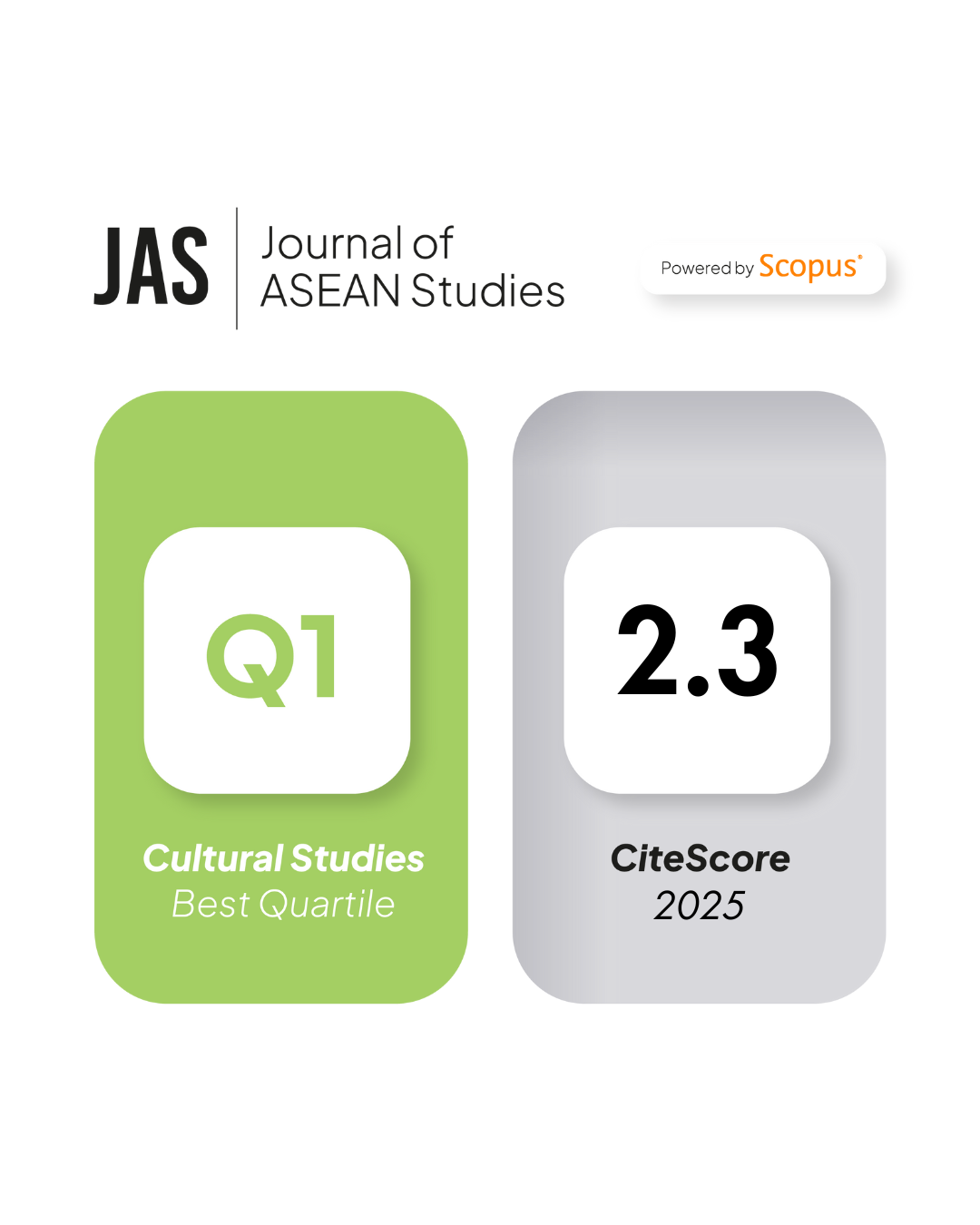A Value Chain Approach to Support Southeast Asian Economic Regionalism
DOI:
https://doi.org/10.21512/jas.v7i1.5009Keywords:
regional economic integration, multilateral trade agreements, ASEAN single market, capital liberalizationAbstract
This article includes an exploration of the economic data sets of the Association of Southeast Asian Nations (ASEAN) Statistics, the World Bank, and the International Monetary Fund, as well as primary regional economic initiatives and agreements to assess the strategic indicators of economic regionalism using thematic analysis. The aim of this research is to determine how Southeast Asian regionalism can circumvent vulnerabilities to another economic crisis in North America and the European Union. To correct such financial vulnerabilities, ASEAN has significantly remolded the region into a single market consisting of a 10-nation integrated production base. The ASEAN Economic Community’s main pillars are the establishment of a regional economic foundation based on comprehensive investment initiatives; the liberalization of capital markets, tariffs, and professional labor; infrastructure connectivity; regional policy integration; and free trade agreements to create a regional value chain as part of a single market and production base. The more attainable this comprehensive value-capture-and-integration process becomes, the more attractive it will appear to the global economic investment community and for business opportunities to establish a robust regional foundation. Although the process appears straightforward, capturing value is not a single phenomenon or method, but rather a multifaceted phenomenon, as explored in this study. The regional integration model seeks profitability within effective cross-border production networks and regional liberalization.
References
ASEAN Secretariat. (2007). ASEAN investment report 2006. Jakarta, Indonesia.
ASEAN Secretariat. (2012). ASEAN Economic Community (AEC) handbook for business 2012. Jakarta, Indonesia.
ASEAN Secretariat. (2013a). ASEAN Economic Community (AEC) chartbook 2012. Jakarta, Indonesia.
ASEAN Secretariat. (2013b). ASEAN investment report 2012. Jakarta, Indonesia.
ASEAN Secretariat. (2017). ASEAN investment report 2017. Jakarta, Indonesia.
ASEANstats. (2017). ASEANstats database. Jakarta, Indonesia: ASEAN Secretariat.
Asian Development Bank. (2017). Asian development outlook 2017 update: Sustaining development through public-private partnership. Asian Development Outlook, 242.
Bhattacharyay, B. N. (2012). Seamless sustainable transport connectivity in Asia and the Pacific: prospects and challenges. International Economics and Economic Policy, 9(2), 147-189.
Calvo-Pardo, H., Freund, C., & Ornelas, E. (2011). Cost and benefits of economic integration in Asia. In R. Barro & J.-W. Lee (Eds.), The ASEAN free trade agreement: Impact on trade flows and external trade barriers (pp. 157-186). London, United Kingdom: Oxford University Press.
Capannelli, G. (2011a). Institutions for economic and financial integration in Asia: Trends and prospects. ADBI Working Paper Series, No. 308. http://hdl.handle.net/10419/53695
Capannelli, G. (2011b). Shaping Asia's institutional architecture for economic and financial integration: Opinion leaders’ views. International Economic Journal, 25, 593-616.
Chia, S. (2013). The ASEAN Economic Community: Progress, challenges, and prospects. ADBI Working Paper Series, No. 440.
Chin, G. (2014). Asian regionalism after the global financial crisis. In G. Capannelli & M. Kawai (Eds.), The political economy of Asian regionalism (pp. 39-58). Tokyo, Japan: Springer.
Chin, G. (2012). Regionalism and economic globalization. ADBI Working Paper 343.
CrimsonLogic. (2010). World's first trade facilitation system: TRADENET. Singapore.
Das, D. K. (2012). How did the Asian economy cope with the global financial crisis and recession? A revaluation and review. Asia Pacific Business Review, 18, 7-25.
Erkens, D. H., Hung, M., & Matos, P. (2012). Corporate governance in the 2007–2008 financial crisis: Evidence from financial institutions worldwide. Journal of Corporate Finance, 18, 389-411.
Goodman, M. (2018). From TPP to CPTPP. Washington DC: Center for Strategic and International Studies.
Hartono, B., Sulistyo, S. R., Praftiwi, P. P., & Hasmoro, D. (2014). Project risk: Theoretical concepts and stakeholders' perspectives. International Journal of Project Management, 32, 400-411.
Hwang, S., & Lee, S. (2015). Regional economic integration and multinational firm strategies. Journal of International Trade & Economic Development, 24, 968-1013.
Intal, P., Dionisius, N., & Fukunaga, Y. (2012). Mid-term review of the implementation of AEC Blueprint: Executive summary. Jakarta, Indonesia: Economic Research Institute for ASEAN and East Asia.
International Monetary Fund. (2018). World economic outlook: Real GDP growth. Washington DC.
Japan Association for Simplification of International Trade Procedures. (2012). ASEAN single window: Hearing survey in 2012. Tokyo, Japan.
Ji, X., Rana, P. B., Chia, W.-M., & Li, C. T. (2018). Trade policy options for ASEAN countries and their regional dialogue partners: “Preference ordering†using CGE analysis. (Rajaratnam School of International Studies - Working Paper No. 308). Singapore: Nanyang Technological University.
Jones, C. (2016). Business strategies for ASEAN's Single Window in Southeast Asia (doctoral dissertation). Available at ProQuest Dissertations & Theses. (UMI No. 10248949)
Kabir, S., & Salim, R. A. (2014). Regional economic integration in ASEAN: How far will it go? Southeast Asian Economies, 31(2), 24.
Masron, T. A., & Nor, E. (2012). FDI in ASEAN-8: Does institutional quality matter? Applied Economics Letters, 20, 186-189.
McCann, D. E. (2013). Managing changes in project scope: The role of the project constraints (doctoral dissertation). Available at ProQuest Dissertations & Theses. (UMI No. 3568940)
Neufeld, N. (2014). Trade facilitation provisions in regional trade agreements: Traits and trends. Journal of International Commerce, Economics and Policy, 5, 145.
Organisation for Economic Co-operation and Development. (2018). Economic outlook for Southeast Asia, China, and India 2018: Fostering growth through digitalisation. Paris, France: OECD Publishing.
Petri, P., & Plummer, M. (2016). The economic effects of the Trans-Pacific Partnership: New estimates (PIIE Working Paper Series WP 16-2). Washington, DC: Peterson Institute for International Economics.
Petri, P., Plummer, M. G., & Zhai, F. (2012). ASEAN Economic Community: A general equilibrium analysis. Asian Economic Journal, 26(2), 93-118.
Project Management Institute. (2013). A guide to the project management body of knowledge (PMBOK® guide) (5th ed.). Newtown Square, PA.
Reinhart, C. M., & Rogoff, K. S. (2013). Banking crises: An equal opportunity menace. Journal of Banking & Finance, 37, 4557-4573.
Sebestyén, Z., & Tóth, T. (2014). A revised interpretation of risk in project management. Periodica Polytechnica Social and Management Sciences, 22, 119-128.
United Nations Conference on Trade and Development. (2017). Foreign direct investment: Inward and outward flows and stock, annual, 1970-2016. Geneva, Switzerland: UNCTADSTAT.
Willig, C. (2014). Interpretation and analysis. In U. Flick (Ed.), The SAGE handbook of qualitative data analysis (pp. 136-151). London, United Kingdom: SAGE.
World Bank. (2018). Total reserves (includes gold, current US$). Washington DC.
Zhang, Y., & Fan, Z.-P. (2014). An optimization method for selecting project risk response strategies. International Journal of Project Management, 32, 412-422.






















